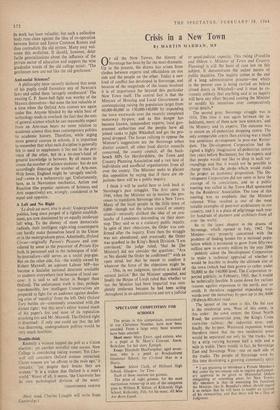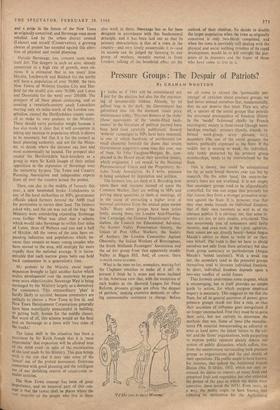Crisis in a New Town
By MARTIN MADDAN, MP
OF all the New Towns, the history of Stevenage has been by far the most dramatic. Up to the present, the drama has arisen from clashes between experts and officialdom on one side and the people on the other. Today a new kind of conflict has developed in Stevenage, and because of the magnitude of the issues involved it is of importance far beyond this particular New Town itself. The central fact is that the Minister of Housing and Local Government is contemplating raising the population target from 60,000-80,000 to 130,000-140,000 by expanding the town westwards over the recently completed motorway by-pass; and as this danger has become known, independent experts, local gov- ernment authorities and the people have all joined ranks to fight Whitehall and get the pro- posal dropped. The forces rallying to oppose the Minister's suggestions are the Stevenage urban district council, all other local district councils concerned, the county council, all the back- bench MPs for. Hertfordshire, the Town .and Country Planning Association and a vast host of individuals and unofficial organisations from all over the county. The Minister seeks to placate this opposition by saying that if there are ob- jections there will be a public inquiry.
I think it will be useful here to look back at Stevenage's past struggles. The first came in 1946, when the Minister set in motion the pro- cesses to transform Stevenage into a New Town. Many of the local people in the little town of 6,000—though not the urban council or county council—naturally disliked the idea of an ava- lanche of Londoners descending on .their door- step. They said so at a statutory public inquiry. In spite of their objections, the Order was con- firmed after the inquiry. Even' then the struggle was not abandoned, and eventually' the Order was quashed in the King's Bench Division. 'I am convinced,' the judge ruled, 'that he [the Minister] did not consider the question: "Aye or No should the Order be confirmed?" with an open mind, but that he meant to confirm it whatever the force of the objections might be. . . . This, in my judgment, involves a denial of natural justice.' But the Minister appealed, and- finally the House of Lords ruled that whether or not the Minister had been impartial was com- pletely irrelevant because he had been acting throughout in an administrative and not a judicial
or quasi-judicial capacity. This ruling (Franklin and Others v. Minister of Town and Country Planning) is still the basis of case law on this subject. It demonstrates the unjust nature of public inquiries. The inquiry comes at the end of a long administrative process—one which in the present case is being carried on behind closed doors in Whitehall—and it must be ex- tremely unlikely that anything said at an inquiry will have any effect beyond causing the Minister to modify his intentions over comparatively trivial details.*
The second great Stevenage struggle was in 1954. This time it was again between the in- habitants, many of them now 'new town-ers,' and the Ministry and its experts. The outcome was to secure an all-pedestrian shopping centre. The only comparable centre then existing was a much less ambitious development in post-war Rotter- dam. The Development Corporation had de- signed a highly imaginative all-pedestrian centre (ten years before Buchanan), but the experts said that people would not like to shop in such sur- roundings and that it would not be possible to charge rents for the shops .which would make the project an economic proposition. The De- velopment Corporation did not seem to have the courage of its convictions, and so a public meeting was called in the Town Hall sponsored by the Residents' Association. The tone of this meeting was so emphatic that the Minister relented. What resulted is one of the most notable examples of post-war architecture in our country, and it is a place of pilgrimage each year for hundreds of planners and architects from all over the world.
So to the latest chapter in the drama of Stevenage, which opened in July, 1962. The Minister—very 'properly concerned with the problem of finding homes for a national popu- lation which is estimated to grow from fifty-two million now to seventy million by the year 2000 --publicly asked the Development Corporation to make a technical appraisal of whether it would be feasible to double the ultimate size of the town (which had then grown to rather under 50,000) to the 140,000 level. The Corporation re- ported publicly, in February, 1963, teat it would be technically feasible. It came down for various reasons against expansion to the north, east or south. It therefore suggested expanding west- wards over the motorway by-pass up to 1110600 (Welwyn-Hitchin) road.
The layout of the town is this. On the east is the residential area. West of this come, in this order : the town centre; the Great North Road; the commercial area; the King's Cross main-line railway; the industrial area; and, finally, the by-pass. Westward expansion would therefore mean that the two residential areas would be separated not only by 'the tracks,' but by a strip varying between half a mile and a mile in width. There would, in fact, be Stevenage East and Stevenage West--one on each side of the tracks. The people of Stevenage were by this time developing a growing community spirit
• I am planning to introduce a Private Member's Bill under the ten-minute rule to require parliament- ary approval to be given to Ministerial Orders designating or extending areas for New Towns. My intention is that• in exercising his functions the Minister, like St. Benediot's abbot. should regard it as certain that he will have to render an account of his stewardship. and that there will be a Day of ,/ udgment.
and a pride in the future of the New Town as originally conceived; and Stevenage once more rebelled. Led by the urban district council (Labour) and myself (Conservative), a growing chorus of protest has sounded against this abor- tion of physical and social planning.
Outside Stevenage, too, concern soon made itself felt. The dangers in such an area, already committed to a high rate of growth, were ob- vious. It is estimated that in ten years' time Hitchin, Letchworth and Baldock (to the north) will have a population of over 70,000; the twin New Towns of Welwyn Garden City and Hat- field (to the south) also over 70,000; and Luton and Dunstable (to the west) over 200,000. The prospect of all these places coalescing, and so creating a twentieth-century south Lancashire starting only six miles north of the London con- urbation, caused the Hertfordshire county coun- cil to make its own protests to the Ministry. These should carry particular weight because it has also made it clear that it will co-operate in taking any increase in population which is shown to be necessary, but that it is for the council as local planning authority, and not for the Minis- ter, to decide where the increase can best and most economically be located. The prospect also caused the Hertfordshire back-benchers as a group to warn Sir Keith Joseph of their united opposition to the expansion of Stevenage over the motorway by-pass. The Town and Country Planning Association and independent experts from all over the country joined the protest.
Then, one .day in the middle of January this year, a new bombshell broke. Unbeknown to any of the local authorities or MPs, government officials asked farmers beyond the A600 road for permission to survey their land. The farmers asked why, and the cat was out of the bag: the Ministry were considering expanding Stevenage even farther. What was afoot was a scheme which would take Stevenage to within four miles of Luton, three of Welwyn and one and a half of Hitchin. All the towns of the area have ex- panding industries and populations which, be- cause they contain so many young couples who have moved to the area, will multiply far more rapidly than the national average. It is incon- ceivable that such narrow green belts can hold back coalescence in a generation's time.
My protests to the Ministry about super- expansion brought to light another factor which makes development over the motorway by-pass even more objectionable. Stevenage West is being envisaged by the Ministry largely as a dormitory for commuters. This extraordinary 'plan' is hardly likely to succeed, because commuters are unlikely to choose a New Town to live in, and New Town Development Corporations generally have been notoriously unsuccessful in building, or getting built, houses for the middle classes. But worst of all, this scheme would set the final seal on Stevenage as a town with `two sides of the tracks.'
The latest shift in the situation has been a statement by Sir Keith Joseph that it is 'most improbable' that expansion will be allowed west of the A600 road—in spite of the examination of the land made by his Ministry. This gain brings With it the risk that it may take some of the `steam' out of the protest movement. Everyone concerned with good planning and the intelligent use of our shrinking reserve of countryside re- mains anxious.
, The New Town concept has been of great importance, and an essential part of this con- cept is that the towns shall be places where the vast majority of the people who live in them also work in them. Stevenage has so far been designed in accordance with this fundamental principle, and it has been laid out so that its primary characteristic is that of a town in the country—and very lovely countryside it is—and its success can be judged by listening to any group of mothers, recently moved in from London, talking of the beneficial effect on the outlook of their children. To decide to double the target population when the town as originally conceived is only two-thirds completed, and When the town is inevitably still dealing with the physical and social teething troubles of its rapid development, would be to kill outright the pur- poses of its founders and the hopes of those who have come to live in it.



































 Previous page
Previous page